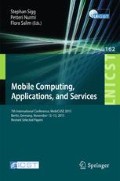Abstract
Transportation mode detection (TMD) is a growing field of research, in which a variety of methods have been developed, foremost for outdoor travels. It has been employed in application areas such as public transportation and environmental footprint profiling. For indoor travels the problem of TMD has received comparatively little attention, even though diverse transportation modes, such as biking and electric vehicles, are used indoors. The potential applications are diverse, and include scheduling and progress tracking for mobile workers, and management of vehicular resources. However, for indoor TMD, the physical environment as well as the availability and reliability of sensing resources differ drastically from outdoor scenarios. Therefore, many of the methods developed for outdoor TMD cannot be easily and reliably applied indoors.
In this paper, we explore indoor transportation scenarios to arrive at a conceptual model of indoor transportation modes, and then compare challenges for outdoor and indoor TMD. In addition, we explore methods for TMD we deem suitable in indoor settings, and we perform an extensive real-world evaluation of such methods at a large hospital complex. The evaluation utilizes Wi-Fi and accelerometer data collected through smartphones carried by hospital workers throughout four days of work routines. The results show that the methods can distinguish between six common modes of transportation used by the hospital workers with an F-score of \(84.2\,\%\).
Access this chapter
Tax calculation will be finalised at checkout
Purchases are for personal use only
Notes
- 1.
In fact, these disturbances are sufficiently significant that they give rise to positioning via fingerprinting instead: given a magnetic field fingerprint collection, a phone’s location can subsequently be estimated within the fingerprinted environment by the local characteristics of the magnetic field as measured by the phone’s magnetometer [1].
- 2.
References
Indoor Atlas. http://www.indooratlas.com. Accessed 3 August 2015
Asmar, D.C., Zelek, J.S., Abdallah, S.M.: Smartslam: localization and mapping across multi-environments. In: Proceedings of International Conference Systems, Man and Cybernetics (2004)
Bahl, P., Padmanabhan, V.N.: Radar: an in-building RF-based user location and tracking system. In: Proceedings of IEEE Conference Computer Communications, pp. 775–784 (2000)
Buchin, K., Buchin, M., van Kreveld, M., Lffler, M., Silveira, R., Wenk, C., Wiratma, L.: Median trajectories. Algorithmica 66(3), 595–614 (2013)
Figo, D., Diniz, P.C., Ferreira, D.R., Cardoso, J.M.P.: Preprocessing techniques for context recognition from accelerometer data. Pers. Ubiquit. Comput. 14(7), 645–662 (2010)
Hammerla, N.Y., Kirkham, R., Andras, P., Plötz, T.: On preserving statistical characteristics of accelerometry data using their empirical cumulative distribution. In: Proceedings of ISWC 2013 (2013)
Hemminki, S., Nurmi, P., Tarkoma, S.: Accelerometer-based transportation mode detection on smartphones. In: ACM SenSys 2013, pp. 13:1–13:14. ACM (2013)
Kjærgaard, M.B., Blunck, H.: Tool support for detection and analysis of following and leadership behavior of pedestrians from mobile sensing data. Pervasive Mob. Comput. 10, 104–117 (2014)
Kjærgaard, M.B., Blunck, H., Godsk, T., Toftkjær, T., Christensen, D.L., Grønbæk, K.: Indoor positioning using GPS revisited. In: Floréen, P., Krüger, A., Spasojevic, M. (eds.) Pervasive 2010. LNCS, vol. 6030, pp. 38–56. Springer, Heidelberg (2010)
LaMarca, A., et al.: Place lab: device positioning using radio beacons in the wild. In: Gellersen, H.-W., Want, R., Schmidt, A. (eds.) Pervasive 2005. LNCS, vol. 3468, pp. 116–133. Springer, Heidelberg (2005)
Prentow, T.S., Thom, A., Blunck, H., Vahrenhold, J.: Making sense of trajectory data in indoor spaces. In: IEEE 16th International Conference Mobile Data Management (2015)
Reddy, S., Mun, M., Burke, J., Estrin, D., Hansen, M., Srivastava, M.: Using mobile phones to determine transportation modes. ACM Trans. Sen. Netw. 6(2), 13:1–13:27 (2010)
Sagha, H., Digumarti, S., del R. Millan, J., Chavarriaga, R., Calatroni, A., Roggen, D., Tröster, G.: Benchmarking classification techniques using the opportunity human activity dataset. In: IEEE Systems, Man, and Cybernetics (SMC) (2011)
Sohn, T., et al.: Mobility detection using everyday GSM traces. In: Dourish, P., Friday, A. (eds.) UbiComp 2006. LNCS, vol. 4206, pp. 212–224. Springer, Heidelberg (2006)
Stenneth, L., Wolfson, O., Yu, P.S., Xu, B.: Transportation mode detection using mobile phones and gis information. In: Proceedings of 19th ACM GIS, pp. 54–63. ACM (2011)
Stisen, A., Blunck, H., Bhattacharya, S., Prentow, T.S., Kjærgaard, M.B., Dey, A., Sonne, T., Jensen, M.M.: Smart devices are different: assessing and mitigating mobile sensingheterogeneities for activity recognition. In: ACM SenSys 2015. ACM (2015)
Stisen, A., Verdezoto, N., Blunck, H., Kjærgaard, M.B., Grønbæk, K.: Accounting for the invisible work of hospital orderlies: designing for local and global coordination. In: ACM CSCW 2016. ACM (2016)
Sun, M., Hill, J.: A method for measuring mechanical work and work efficiency during human activities. J. Biomech. 26(3), 229–241 (1993)
Takagi, M., Fujimoto, K., Kawahara, Y., Asami, T.: Detecting hybrid and electric vehicles using a smartphone. In: ACM UbiComp 2014, pp. 267–275 (2014)
Tarzia, S.P., Dinda, P.A., Dick, R.P., Memik, G.: Indoor localization without infrastructure using the acoustic background spectrum. In: Proceedings of MobiSys 2011 (2011)
Varshavsky, A., de Lara, E., Hightower, J., LaMarca, A., Otsason, V.: GSM indoor localization. Pervasive Mob. Comput. 3(6), 698–720 (2007)
Witte, T., Wilson, A.: Accuracy of non-differential GPS for the determination of speed over ground. J. Biomech. 37(12), 1891–1898 (2004)
Wüstenberg, M., Blunck, H., Grønbæk, K., Kjærgaard, M.B.: Distinguishing electric vehicles from fossil-fueled vehicles with mobile sensing. In: IEEE MDM (2014)
Zheng, Y., Chen, Y., Li, Q., Xie, X., Ma, W.: Understanding transportation modes based on GPS data for web applications. TWEB 4(1) (2010)
Author information
Authors and Affiliations
Corresponding author
Editor information
Editors and Affiliations
Rights and permissions
Copyright information
© 2015 Institute for Computer Sciences, Social Informatics and Telecommunications Engineering
About this paper
Cite this paper
Prentow, T.S., Blunck, H., Kjærgaard, M.B., Stisen, A. (2015). Towards Indoor Transportation Mode Detection Using Mobile Sensing. In: Sigg, S., Nurmi, P., Salim, F. (eds) Mobile Computing, Applications, and Services. MobiCASE 2015. Lecture Notes of the Institute for Computer Sciences, Social Informatics and Telecommunications Engineering, vol 162. Springer, Cham. https://doi.org/10.1007/978-3-319-29003-4_15
Download citation
DOI: https://doi.org/10.1007/978-3-319-29003-4_15
Publisher Name: Springer, Cham
Print ISBN: 978-3-319-29002-7
Online ISBN: 978-3-319-29003-4
eBook Packages: Computer ScienceComputer Science (R0)

